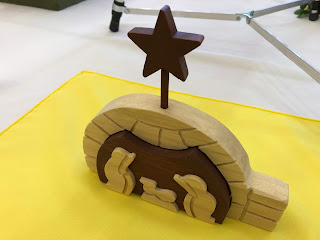A Fanciful Christmas Story
I saw a different rendition of the Christmas story recently at Springfield's Chiara Center. I attended the Franciscan Nativity Festival and enjoyed a cursory review of more than 120 nativity scenes on loan to display for the festival. When I first saw this particular nativity, I was taken aback by the simple depiction of three figures inside an igloo with a large star prominently displayed at the top of the ice block house. What really captured my imagination were the three unique figures symbolizing Mary, Joseph and baby Jesus in the manger. Presumably, a Chicago artist depicted these Christmas characters as a family of Eskimos dressed in traditional Alaskan hooded parkas.
However fanciful this take on the Christmas nativity was for the creator of this piece, the owner of this set told the story of why she was taken with it. This unique piece reminded her of the years she had spent as a volunteer, living in Alaska among the Yupik Eskimos. The Yupik (pronounced, yoop-eek) are an indigenous and aboriginal peoples who inhabit western and southwestern Alaska as well as the Russian Far East. They settled in these territories about 3000 years ago and today, their population is just over 25,000.
At first, I questioned the appropriateness of such a fanciful interpretation. After all, biblical history tells us that Jesus was born in Bethlehem of Judea. I confess that I had snapped a photo of this nativity because I was tracking all those that had a star associated with it. And there were many. But as I studied this "Eskimo Nativity," the more I was smitten with it. Of all the photographs I took that afternoon, I must say that this precious and simply stated little nativity has become my favorite! I have studied it and studied it with growing appreciation. It captures the innocence and humility of Christ's birth as well as any of the nativity scenes that I reviewed.
There was nothing fanciful about the Apostle John's take on the Christmas story. This unusual description of the Incarnation sounds more like a philosophy lesson than a birth narrative. Celebrating the Deity of Christ, John, with poetic phrasing introduces the fourth gospel and the Coming Christ this way: "In the beginning was the Word, and the Word was with God, and the Word was God. He was with God in the beginning" (John 1:1-2). Then, John makes a succinct and memorable statement that connects Christ with all of humanity: "The Word became flesh and made his dwelling among us" (1:14a). Literally and vividly, Christ "pitched His tent" (to dwell) in humanity to live among us.
In this prologue, John used the Greek idea of logos to describe the coming Christ. Logos was the Ultimate Reason and controlling factor of all reality. Christ, as The Logos of God, brings meaning and order to all things. Because of the Incarnation, we are assured that the world is not a chaotic, spherical mess that is full of random events. Rather, salvation history is purposive and linear. God is working from eternity to eternity to set forth His plan for all the created order. Christ's coming was a God-planned birth with one specific purpose - "To seek and to save the lost!" (Luke 19:10).
What do you see in the manger scene? How do you imagine it all looked that night long ago? If you were part of an ancient people living in the tundra of North America, what would Christmas look like to you? Would it be a fanciful family of three dwelling in a borrowed igloo? When you look at the manger in your mind's eye, do you see your kind of people in the scene? This Christmas season reminds us that God sees all of His people on planet earth, the entire human family, needing a Savior and He lovingly sent His Son to earth to dwell among us as "The glory of the One and Only... full of grace and truth!" (1:14b).
Mike Keppler, retired pastor,
active churchman and
doting grandparent.
Contact: drmjkeppler@gmail.com
 |
| Eskimo Nativity Courtesy of R. Pruitt, Springfield |
However fanciful this take on the Christmas nativity was for the creator of this piece, the owner of this set told the story of why she was taken with it. This unique piece reminded her of the years she had spent as a volunteer, living in Alaska among the Yupik Eskimos. The Yupik (pronounced, yoop-eek) are an indigenous and aboriginal peoples who inhabit western and southwestern Alaska as well as the Russian Far East. They settled in these territories about 3000 years ago and today, their population is just over 25,000.
At first, I questioned the appropriateness of such a fanciful interpretation. After all, biblical history tells us that Jesus was born in Bethlehem of Judea. I confess that I had snapped a photo of this nativity because I was tracking all those that had a star associated with it. And there were many. But as I studied this "Eskimo Nativity," the more I was smitten with it. Of all the photographs I took that afternoon, I must say that this precious and simply stated little nativity has become my favorite! I have studied it and studied it with growing appreciation. It captures the innocence and humility of Christ's birth as well as any of the nativity scenes that I reviewed.
In this prologue, John used the Greek idea of logos to describe the coming Christ. Logos was the Ultimate Reason and controlling factor of all reality. Christ, as The Logos of God, brings meaning and order to all things. Because of the Incarnation, we are assured that the world is not a chaotic, spherical mess that is full of random events. Rather, salvation history is purposive and linear. God is working from eternity to eternity to set forth His plan for all the created order. Christ's coming was a God-planned birth with one specific purpose - "To seek and to save the lost!" (Luke 19:10).
What do you see in the manger scene? How do you imagine it all looked that night long ago? If you were part of an ancient people living in the tundra of North America, what would Christmas look like to you? Would it be a fanciful family of three dwelling in a borrowed igloo? When you look at the manger in your mind's eye, do you see your kind of people in the scene? This Christmas season reminds us that God sees all of His people on planet earth, the entire human family, needing a Savior and He lovingly sent His Son to earth to dwell among us as "The glory of the One and Only... full of grace and truth!" (1:14b).
Mike Keppler, retired pastor,
active churchman and
doting grandparent.
Contact: drmjkeppler@gmail.com



As the Program Director at the Chiara Center, it is an honor to read your thoughts after having walked among these many interpretations of the one great story. I appreciate that you summoned forth the confounding and beautiful telling of incarnation from John's gospel. As a place of Franciscan spirituality, we revel in the incarnation of the Christ in our midst who came from LOVE to be LOVE amidst a darkened world so in need of hope. Thank you for writing this imaginative account of having spent time seeing our display.
ReplyDeleteThank you, friend, for your gracious words! The ministry of spiritual formation through the Chiara Center is a blessing to many of us!
ReplyDelete